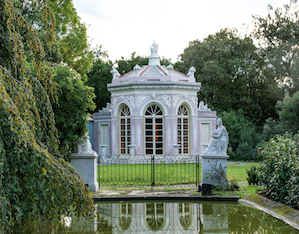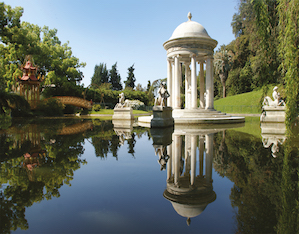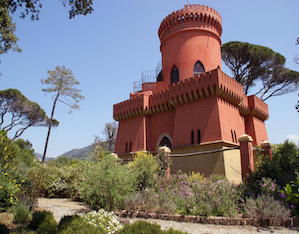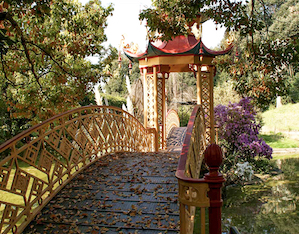A path from the seaside to a hilltop offers visitors views of lush vegetation at every turn. Each scene along the way is staged like a theatrical act, indicating the route from darkness to knowledge, akin to elevation on a Masonic journey of initiation.
In 1840, Marquis Ignazio Pallavicini commissioned Architect Michele Canzio to create this garden as a trailblazing example of a Masonic path, divided into a sequence of scenes that, together, form a complete theatrical work. Every element has a specific meaning, the garden’s eclectic decor providing a transition from urban civilization to a life immersed in nature. From the palm garden, reproducing a painted backdrop from the Carlo Felice Theatre in Genoa, the path runs to the old lake with a waterfall fed by an aqueduct, and then on to a grove of camellias. The next act of this opera is a neo-Gothic ruined castle and votive aedicule, representing the anguish of human busyness. The ascent continues up to the Castello del Capitano, built in Gothic-Moorish style, with a crenellated tower looking out from the top of the hill, and views as far as the Gulf of Portofino and the Ponente Riviera. The descent down the eastern side of the hill leads through dark, eerie caves with artificial stalactites and stalagmites, before opening out onto a bright grassy clearing dominated by an obelisk, symbolizing the passage from the darkness of superstition to the light of knowledge. Next comes the shores of the main lake, in the middle of which stands a classical-inspired circular temple dedicated to Diana. This area is surrounded by eclectic decor – a pagoda and Chinese bridge, Turkish kiosk, the Pavilion of Flora – that combines to offer a peaceful, soothing spectacle, a reward for those who have abandoned the darkness of ignorance for the light of knowledge.
Highlights

The Garden of Flora
This garden’s complex scenography symbolizes earthly paradise. Two statues of “gardeners”, one bearing flowers, the other bearing fruits, usher us into a graceful octagonal pavilion in delicate colours dedicated to Flora, and then a semi-circular cast iron greenhouse overflowing with flowers and a statue of a winged Sylph in its centre. All of these elements help foster serenity in purified souls.

The Avenue of Camellias
Considered Italy’s oldest collection of camellias, dating back to the mid-19th century, its rare varieties include the “Vergine di Collebeato”, which has been the symbol of the Italian Camellia Society since 1965. Pure white in colour, the flower has a unique “architecture” of seven concentric spirals of overlapping petals, decreasing in size towards the centre.

Main Lake
This bright, open scene was originally reached by visitors in swan-shaped boats as they emerged from the darkness of the cave to this scene of harmony and balance. The small round temple in the center of the lake is dedicated to Diana, the goddess who symbolizes nature, flanked by a dog, symbolizing fidelity and perseverance along the path to knowledge.

The Captain’s Castle
This small, compact building sits on a square base, its body surmounted by a cylindrical tower with battlements. The dark, gloomy ground floor symbolizes matter; the tower contains a single circular room, symbolizing the soul freed from all burdens, including a blinding phantasmagoria of stained glass windows, the colours changing as the day progresses.

Chinese Bridge and Pagoda
Small architectural works in a variety of styles were common in 18th-century Anglo-Chinese gardens, revealing Canzio’s knowledge of gardens beyond the Alps, where this style was widely adopted. Among other things, the juxtaposition of Egyptian, Turkish and Roman typologies is a reference to the universality of a Masonic approach to gardens.
 Villa Durazzo Pallavicini
Contacts
Villa Durazzo Pallavicini
Contacts
Contacts
Telephone:+39 010 8531544
+39 393 8830842
Address
Via Ignazio Pallavicini, 13
16155, Genova (GE)
 Villa Durazzo Pallavicini
Opening times and prices
Villa Durazzo Pallavicini
Opening times and prices
Opening hours
From 27 February to 27 March and from 1 October to 30 October
- from Tuesday to Friday from 9:30 a.m. to 6:00 p.m. (last admission at 4:00 p.m.)
- Saturday – Sunday 10:00 a.m. to 6:00 p.m. (last admission at 4:00 p.m.)
From 28 March to 30 September
- from Tuesday to Friday from 9:30 a.m. to 7:00 p.m. (last admission at 5:00 p.m.)
- Saturday – Sunday 10:00 a.m. to 7:00 p.m. (last entrance at 5:00 p.m.)
On 31 October and 1 November
- from Tuesday to Friday from 9:30 a.m. to 7:00 p.m. (last admission at 5:00 p.m.)
The Castle, the Caves and the Green Room are open to the public only on weekends and holidays.
The Park is closed from 2nd November to 26th February; extraordinary openings according to the calendar during the winter period.
Pricing
Midweek
- Full price: € 11
- Reduced price ticket: € 9 (over 65, residents of Genoa Municipality, disabled people, ICOM members)
- Reduced price: € 5 (7-18 years old, schools, members APS Friends of Villa Pallavicini)
- Free (0-6 years old, journalists, disabled accompanying persons)
- Family package: € 24 (2 adults + child 7-18 years old)
- Combined ticket: € 13 (Park + Museum)
Weekends and holidays
- Full price: € 13
- Reduced price ticket: € 10 (over 65, residents of Genoa Municipality, disabled people, ICOM members)
- Reduced price: € 6 (7-18 years old, schools, members APS Amici di Villa Pallavicini)
- Free (0-6 years old, journalists, disabled accompanying persons)
- Family package: € 27 (2 adults + child 7-18 years old)
- Combined ticket: € 16 (Park + Museum)
 Villa Durazzo Pallavicini
How to get there
Villa Durazzo Pallavicini
How to get there
Address
Via Ignazio Pallavicini, 13
16155, Genova (GE)
Latitude: 44.425689
Longitude: 8.817285
How to arrive by road
Coming from the east (A12): exit Genova ovest, take the SS1 Aurelia or the highway towards Savona.
Return to the east: Aurelia towards the city centre, at Sampierdarena follow signs for the A12 motorway (Genova Ovest entrance).
For those coming from the West: unchanged traffic conditions Genoa elevated and expressway are passable in both directions.
How to arrive by train
The entrance to the park is next to the Genoa Pegli station, easily reached by regional trains.
How to arrive by bus
From the centre of Genoa take bus 1, direction Voltri.
Additional directions
How to get there by shipbus:
From the Porto Antico of Genoa next to the Aquarium; check activation of the service on the day according to weather conditions.
 Villa Durazzo Pallavicini
Services/Accessibility
Villa Durazzo Pallavicini
Services/Accessibility
Services
Inside the park there is a bar-bistro open on weekends and holidays during the opening period.
Dogs are not allowed.
There are free and paid parking spaces in the areas surrounding the villa.
The park's educational offerings include guided tours for schools, from elementary to high school. Guided tours are also available for groups of adults. Reservation is necessary, agreeing in advance the date and method of visit by writing to [email protected] or call +39 010 8531544 and +39 393 8830842.
Accessibility
Guided tour with special attention to all people with psychosensory disabilities.
Possibility, on request, of a guided tour with LIS interpreter.
Due to the temporary closure of the Museum/Palace, access to the Park is not guaranteed for people with motor disabilities. Information and reservations at +39 010 8531544 and +39 393 8830842 or by writing to [email protected]
 Villa Durazzo Pallavicini
Private events
Villa Durazzo Pallavicini
Private events
 Villa Durazzo Pallavicini
Itineraries
Villa Durazzo Pallavicini
Itineraries
You could find the garden in these itineraries
 Favorite saving result
Favorite saving result
 Warning!
Warning!
You've have to sign up or sign in to add this element to your favorites.
